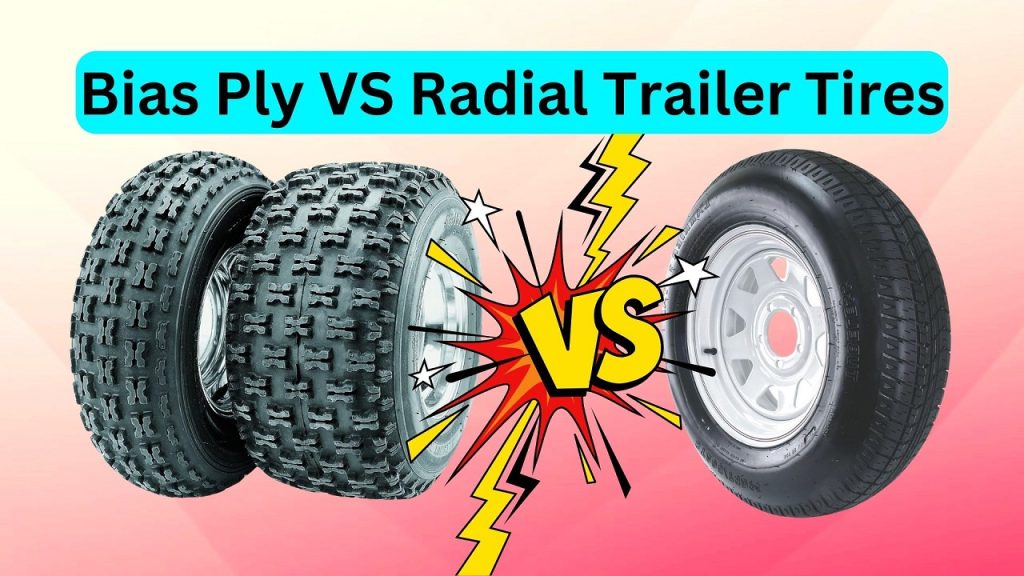Explore the difference between Bias Ply vs Radial Trailer Tires. Choose the best solution for your trailer performance and safety. It is essential to consider the condition of your trailer tires for road safety. Picking the appropriate tires for your trailer is essential for a safe & seamless travel.
This article will assist you in making an informed choice by comparing Radial and Bias Ply Trailer Tires. Which tire type do you prefer—radial tires for longer life and higher performance, or bias ply for its price and durability? To assist you in selecting the ideal tire for your trailer, let’s examine these possibilities.
Bias Ply VS Radial Trailer Tires
Bias Ply Trailer Tires
Construction
Tires with bias plies are made up from multiple rubber coated fabric plies that are traveled across at a position of between 30 and 45 degrees to the direction of travel.
Power
They are perfect for heavy cargo and difficult terrain on trailers because of their stronger sidewalls that increase their durability against punctures and excessive sway.
Heat Development
Because of the way products are made, bias ply tires have a tendency to produce more heat when in functioning, this can result in increased wear and a shorter lifespan of the tire.
Price
Bias ply tires are generally priced lower than radial car tires, which makes them a sensible option in some trailer applications.
Related: All Weather Tires VS Snow Tires: A Comprehensive Review
Related: Goodyear Assurance VS Michelin Defender-Which Tire Better?
Radial Trailer Tires
Building
Radial tires are constructed with layers of cord plies that are 90 degrees angled toward the direction of travel.
Adaptability
Radial tires are made in a way that makes them more flexible. It provides a smoother ride, extending their lifespan and increasing fuel efficiency.
Heat Transfer
Compared to bias ply tires, they conduct heat more efficiently during operation, lowering the possibility of overheating and increasing tire longevity overall.
Achievement
Because of their design, radial trailer tires typically provide superior stability at higher speeds and work well on highways.
Key Differences

1. Construction
The crossed plies on bias ply tires give them durability for high loads and rough terrain, but they may also result in a rougher ride. The radially oriented plies of radial tires provide increased comfort and flexibility while driving on highways.
2. Heat Generation
When operating, bias ply tires produce more heat than radial tires, which reduces their lifespan and performance in high-stress situations.
3. Ride Quality
Radial trailer tires typically offer a smoother ride due to their flexible construction, which can result in improved handling and comfort during towing compared to bias ply options.
In summary
Think about the requirements and intended usage of your trailer before selecting between bias ply and radial trailer tires. Cheaper and more suitable for towing large loads are bias ply tires. Radial tires are more effective at saving fuel, have a longer lifespan, and provide superior road performance. The trailer’s intended usage, load requirements, and budget all influence your decision. To be sure you choose the correct tire, consult a tire specialist before making a decision.
Frequently Asked Question
Is radial or bias ply better for trailer tires?
Radial ply tires are typically thought to be superior to bias ply tires for trailers. When compared to bias ply tires, radial tires offer superior fuel economy, heat dissipation, and frequently longer tread life. They are a favored option for trailers as they provide greater stability & more comfortable ride.
What is a major disadvantage of a bias ply tire?
Tires bias ply construction tend to generate hotter operating temperatures than radial tires. This is one of their primary disadvantages. This higher heat accumulation may result in shorter tire lifespans and decreased performance.
Can you mix radial and bias tires on a trailer?
Combining bias and radial tires on the same trailer is not advised. A trailer stability and control may be affected when its tires are changed which could be hazardous. It is best to use tires with matching construction (all bias or all radial) for maximum performance and safety.
Why do trailers still use bias ply tires?
In certain situations trailers employ bias ply tires because these tires are cheaper as well as have the capacity for supporting big loads at slower speeds. When load capacity and expense are more essential than fuel economy or high-speed efficiency, it makes sense. Bias ply tires are renowned for being durable and strong.
Are bias ply tires OK for trailers?
Bias ply tires are useful for trailers, especially when heavy loads are being hauled at a slower pace. Because of their durability & longevity, they are a reasonably priced solution for an array of trailer kinds. However, radial tires may be more efficient at dissipating heat, using less fuel, and managing high speeds.
The Next Road (thenextroad.com) is an affiliate of the Amazon Services LLC Associates Program, so you can access the Amazon marketplace when on this domain. We will earn a commission from your qualified purchases.